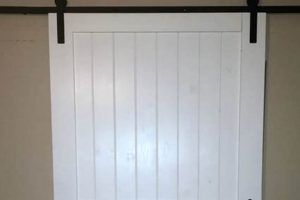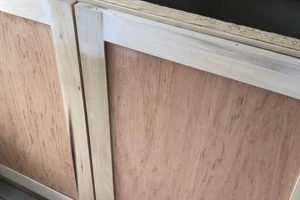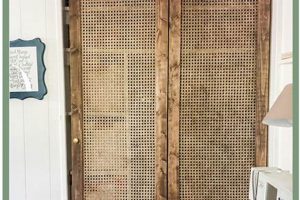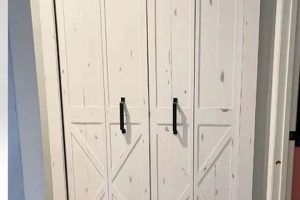A self-constructed barrier designed to allow ventilation while preventing the entry of insects, typically fabricated from lumber and mesh, represents a common home improvement project. These barriers are often installed in exterior doorways to enhance comfort and reduce reliance on artificial climate control. The construction process typically involves framing a wooden structure, securing screening material within that frame, and installing hardware for operation.
The advantages of undertaking such a project include cost savings compared to professional installation, customization options to suit specific architectural styles and dimensions, and the inherent satisfaction derived from completing a hands-on task. Historically, these barriers have been a fundamental element of residential architecture in climates where insect populations are prevalent, offering a low-tech solution for natural ventilation. Their continued relevance is evident in the increasing interest in sustainable and energy-efficient home design.
This discussion will now explore the essential aspects of planning, constructing, and installing such a structure, covering material selection, tool requirements, joinery techniques, and methods for ensuring a durable and aesthetically pleasing final product. Guidance will be provided on selecting appropriate screening materials, hardware components, and finishing techniques to ensure longevity and performance.
Essential Considerations for Screen Door Construction
The following recommendations aim to optimize the design and construction of a functional and durable screen door.
Tip 1: Wood Selection. Opt for naturally decay-resistant wood species, such as cedar, redwood, or cypress, to minimize deterioration from exposure to the elements. Proper drying of the lumber prior to construction is paramount to prevent warping and cracking.
Tip 2: Frame Joinery. Employ robust joinery techniques, such as mortise and tenon or half-lap joints, to ensure the frame’s structural integrity. Gluing and screwing these joints further enhances their strength and resistance to racking.
Tip 3: Screening Material. Select screening material appropriate for the environment. Aluminum screening offers greater durability, while fiberglass screening provides flexibility and is less prone to denting. Secure the screening tautly and evenly to the frame using appropriate fasteners or spline.
Tip 4: Hardware Selection. Utilize corrosion-resistant hardware, such as stainless steel or brass, for hinges, latches, and handles. Proper hinge placement is crucial to ensure smooth operation and prevent sagging.
Tip 5: Finishing. Apply a high-quality exterior-grade paint or sealant to protect the wood from moisture and UV damage. Ensure all surfaces are properly primed before applying the finish coat.
Tip 6: Accurate Measurements. Precise measurements of the door opening are critical to ensure a proper fit. Account for clearances necessary for smooth operation and hardware installation.
Tip 7: Proper Installation. Ensure the door frame is plumb and square prior to installation. Use shims as needed to achieve a tight and even fit. Proper alignment of the latch is crucial for secure closure.
Implementing these recommendations during the planning and construction phases will result in a more durable, functional, and aesthetically pleasing barrier.
The subsequent sections will detail the specific steps involved in the screen door building process.
1. Frame Material
The selection of lumber for the frame in a self-constructed barrier significantly impacts its overall longevity, structural integrity, and aesthetic appeal. The chosen material dictates the door’s resistance to environmental factors, its weight, and the ease with which it can be worked.
- Wood Species Durability
Different wood species exhibit varying degrees of natural resistance to decay, insect infestation, and moisture absorption. Cedar, redwood, and cypress possess inherent oils that protect them from these elements, making them ideal choices for exterior applications. Conversely, pine and fir, while more economical, require thorough treatment with preservatives to achieve comparable durability. The choice hinges on a balance between cost and desired lifespan.
- Dimensional Stability
Dimensional stability refers to a wood’s ability to maintain its shape and size when exposed to changes in humidity and temperature. Species like mahogany and teak are known for their exceptional dimensional stability, minimizing warping and cracking. Less stable woods require careful sealing and finishing to mitigate these issues, potentially adding to the overall project cost and labor.
- Workability
The ease with which a wood can be cut, shaped, and fastened is a crucial factor for many builders. Softer woods like pine are easier to work with hand tools, while hardwoods like oak require specialized equipment. The choice should align with the builder’s skill level and the available tools. A more workable material reduces the risk of errors and simplifies the construction process.
- Aesthetic Considerations
The grain pattern, color, and texture of the wood contribute significantly to the final product’s appearance. Some builders may prefer the rustic look of reclaimed lumber, while others opt for the clean lines of clear, knot-free wood. The selected material should complement the architectural style of the home and reflect the builder’s personal preferences. The aesthetic choice should complement the functionality and durability.
Therefore, the careful selection of the frame material is a foundational decision in the creation. A well-chosen material ensures the door withstands the rigors of daily use and exposure to the elements, providing years of reliable service and enhancing the overall value of the home. Consideration of these various factors allows for an informed decision, balancing cost, durability, and aesthetics to achieve the desired result.
2. Screening Type
The performance and longevity of a self-assembled barrier are intrinsically linked to the selection of screening material. The screening serves as the primary defense against insects and debris, while simultaneously permitting airflow. Material choice directly influences visibility, resistance to damage, and overall aesthetic integration. For instance, fiberglass screening, a common choice, offers flexibility and cost-effectiveness; however, it is susceptible to punctures and degradation from prolonged sun exposure. Conversely, aluminum screening presents enhanced durability and resistance to damage from pets or harsh weather conditions, albeit at a higher cost and with potentially reduced visibility due to its metallic composition. Improper selection leads to frequent repairs or premature replacement, negating the cost benefits of the self-assembly process.
Beyond material composition, mesh size is a critical factor. Finer mesh effectively blocks smaller insects, such as no-see-ums, but can impede airflow and accumulate dust and pollen, requiring more frequent cleaning. Coarser mesh provides better ventilation but may permit entry to smaller pests. The intended application dictates the optimal mesh size; for example, a barrier in a mosquito-prone area necessitates a finer mesh compared to one in a relatively pest-free environment. The securing method also affects performance. Improper tensioning of the screening during installation leads to sagging and potential insect entry, highlighting the importance of using appropriate tools and techniques, such as spline rollers and specialized stretching devices. Real-world examples include situations where poorly installed fiberglass mesh quickly tears due to pet activity, or where insufficient mesh allows persistent insect infiltration, rendering the barrier ineffective.
In conclusion, the selection of screening material is a pivotal decision, demanding careful consideration of environmental factors, intended use, and available budget. The type affects functionality and longevity, underscoring the importance of informed material choice and proper installation. Addressing challenges related to durability and maintenance ensures a worthwhile outcome and maximizes the practical benefits of a self-assembled barrier.
3. Joinery Strength
The structural integrity of a self-constructed barrier is fundamentally dependent on the strength of its joinery. Deficient joinery compromises the frame’s ability to withstand daily use, exposure to the elements, and the stresses imposed by opening and closing. This direct correlation means that a seemingly cost-effective or aesthetically pleasing design becomes unsustainable if its joints lack the necessary robustness. Consequently, the method selected for connecting the frame members is not merely a construction detail but a determinant of overall performance and longevity.
Common joinery techniques applicable to a wood screen door include mortise and tenon, half-lap, and dowel joints. Mortise and tenon joints, characterized by a projecting tenon fitting precisely into a mortise (hole), offer superior strength and resistance to racking forces. These are frequently employed at the corners of the frame, where stress concentration is highest. Half-lap joints, where two pieces of wood are joined by removing half of the thickness of each at the joint, provide a large gluing surface and reasonable strength, particularly when reinforced with fasteners. Dowel joints, utilizing cylindrical pins inserted into corresponding holes, are a simpler alternative but generally less robust, suitable for lighter-duty applications or when combined with adhesives. The choice depends on factors such as wood species, dimensions of the frame members, and anticipated usage.
In summary, joinery strength is a critical factor in determining the long-term performance and reliability of a barrier. The selection of appropriate joinery techniques, coupled with meticulous execution, ensures the frame maintains its structural integrity, resisting warping, sagging, and eventual failure. This understanding translates directly to practical benefits, reducing the need for repairs or replacements and extending the lifespan of the project. While other elements contribute to the final product’s success, without adequate joinery strength, the entire structure is fundamentally compromised.
4. Hardware Durability
The operational lifespan and functionality of a self-constructed wood screen barrier are substantially influenced by the durability of its hardware components. These components, subjected to repetitive use and environmental exposure, dictate the ease of operation, security, and overall longevity of the door.
- Hinge Composition and Load Capacity
Hinges facilitate the pivotal movement of the door, bearing its weight and enduring repeated stress. Stainless steel or brass hinges provide superior corrosion resistance compared to coated steel, particularly in coastal environments. The load capacity rating must exceed the door’s weight to prevent sagging and ensure smooth operation. Improper hinge selection leads to premature failure, requiring replacement and potential frame damage.
- Latch Mechanism and Security
The latch secures the door in its closed position, deterring unauthorized entry and preventing unwanted opening due to wind. Solid brass or stainless steel latches offer increased security and weather resistance compared to their zinc alloy counterparts. A robust latch mechanism, properly installed and maintained, contributes significantly to the door’s security and functionality. Latch failure compromises security and necessitates immediate repair.
- Handle Material and Ergonomics
The handle facilitates opening and closing the door, requiring a durable and comfortable design. Stainless steel or brass handles provide resistance to corrosion and wear, while ergonomic designs enhance ease of use. Poorly designed or constructed handles degrade the user experience and may require frequent replacement due to breakage or discomfort. Handle selection should consider both durability and user comfort.
- Fasteners and Corrosion Resistance
Screws and bolts secure the hardware to the wooden frame, requiring corrosion resistance to prevent weakening and eventual failure. Stainless steel fasteners offer superior performance in exterior applications, resisting rust and maintaining structural integrity. The use of inappropriate fasteners leads to hardware loosening, corrosion-induced damage, and potential structural instability. Proper fastener selection is crucial for long-term hardware performance.
The preceding factors demonstrate that hardware durability is not a peripheral consideration but an integral aspect of barrier design and construction. A deliberate selection of high-quality, corrosion-resistant hardware components ensures smooth operation, enhanced security, and prolonged service life, maximizing the investment in a self-constructed wood screen barrier.
5. Weather Resistance
The susceptibility of self-constructed wood screen barriers to environmental elements necessitates a focused consideration of weather resistance. The degree to which such a structure can withstand moisture, ultraviolet radiation, and temperature fluctuations directly correlates with its longevity and functional efficacy. Inadequate weatherproofing leads to premature degradation, necessitating frequent repairs or replacement.
- Material Selection and Natural Durability
The inherent properties of the selected lumber significantly impact the barrier’s capacity to resist weathering. Species such as cedar, redwood, and cypress contain natural oils that provide inherent protection against moisture absorption, decay, and insect infestation. Conversely, less durable woods, such as pine or fir, necessitate application of chemical preservatives or sealants to achieve comparable levels of protection. For example, a barrier constructed from untreated pine, exposed to consistent rainfall, will exhibit signs of rot within a significantly shorter timeframe than one crafted from naturally resistant cedar.
- Protective Coatings and Sealants
Application of exterior-grade paints, stains, or clear sealants forms a crucial barrier against moisture penetration and ultraviolet radiation. These coatings reduce water absorption, minimizing swelling, warping, and cracking of the wood. Furthermore, ultraviolet inhibitors prevent the breakdown of lignin, a component of wood, which contributes to surface graying and structural weakening. An illustrative scenario involves a barrier that is coated with a UV-resistant sealant retaining its original color and structural integrity, whereas an uncoated barrier gradually fades and becomes brittle upon prolonged sun exposure.
- Construction Techniques and Water Management
Incorporating design elements that facilitate water runoff minimizes prolonged moisture exposure. Sloping top rails, properly sealed joints, and adequate ventilation prevent water accumulation and promote rapid drying. For example, a door with a flat, unsealed top rail accumulates standing water, fostering decay. Conversely, a door with a beveled top rail and sealed joints effectively channels water away from vulnerable areas, extending its service life.
- Hardware Selection and Corrosion Prevention
The selection of corrosion-resistant hardware, such as stainless steel or brass hinges and fasteners, is essential for maintaining structural integrity in the face of environmental exposure. Ferrous metals, if unprotected, will rust and weaken over time, compromising the function of the door and potentially staining the wood. An instance of this is a barrier with steel hinges that corrode and seize, hindering smooth operation and potentially causing the frame to crack under stress.
The interconnectedness of these factors underscores the importance of a holistic approach to weatherproofing a self-assembled wood screen barrier. Diligent consideration of material selection, protective coatings, construction techniques, and hardware selection ensures a structure capable of withstanding the rigors of environmental exposure, delivering long-term functionality and value.
6. Accurate Fit
Achieving a precise fit is paramount to the successful creation and operation of a self-constructed wood screen barrier. The dimensional accuracy between the door frame and the existing doorway directly influences the barrier’s functionality, security, and energy efficiency. A misaligned or improperly sized structure invites a cascade of problems, including air infiltration, insect ingress, operational difficulties, and potential structural damage to both the door and the surrounding frame. The causal relationship is clear: inaccurate measurements and construction practices invariably lead to compromised performance.
As a critical component of any such project, accurate fit dictates the barrier’s ability to effectively seal the doorway. Even minor discrepancies result in gaps that negate the intended purpose of insect exclusion and thermal regulation. For example, a screen barrier that is 1/4 inch too narrow allows insects to enter, rendering the screening ineffective. Similarly, a barrier that binds against the door frame impedes smooth operation, placing undue stress on the hinges and latch mechanism. Real-world instances frequently demonstrate the practical significance of precision; an ill-fitting door subjects occupants to drafts, increased heating and cooling costs, and persistent insect infestations, diminishing the overall comfort and utility of the dwelling.
In summary, accurate fit is not merely a cosmetic concern but a fundamental requirement for ensuring the functionality and longevity of a self-assembled wood screen barrier. Challenges arise from inaccurate measurements, imprecise cutting techniques, and inconsistencies in wood dimensions. Addressing these challenges through meticulous planning, accurate measurements, and careful execution is crucial for achieving a well-sealed, smoothly operating, and aesthetically pleasing barrier. An improperly fitted barrier undermines the benefits of the project and invites a host of operational and environmental problems.
Frequently Asked Questions about DIY Wood Screen Doors
The subsequent section addresses common inquiries regarding the design, construction, and maintenance of self-assembled wood screen doors. These questions aim to clarify essential aspects and mitigate potential challenges.
Question 1: Which wood species are best suited for a DIY wood screen door construction to withstand environmental exposure?
Wood species with inherent resistance to decay, insect infestation, and moisture absorption are optimal. Cedar, redwood, and cypress offer natural durability, minimizing the need for chemical treatments. Pine and fir, while more economical, require thorough preservation to achieve comparable longevity.
Question 2: What type of joinery is most effective for ensuring the structural integrity of a DIY wood screen door frame?
Mortise and tenon joints provide superior strength and resistance to racking forces, particularly at corners where stress is concentrated. Half-lap joints, offering a large gluing surface, are also effective when reinforced with fasteners. Dowel joints are suitable for lighter-duty applications when combined with adhesives.
Question 3: What factors should be considered when selecting screening material for a DIY wood screen door?
Durability, visibility, and intended use dictate the optimal screening material. Aluminum screening offers greater resistance to damage, while fiberglass screening provides flexibility and cost-effectiveness. Mesh size should align with the need to exclude specific insect types, balancing airflow with pest control.
Question 4: What type of hardware is recommended for ensuring smooth operation and longevity of a DIY wood screen door?
Corrosion-resistant hardware, such as stainless steel or brass, is essential for hinges, latches, and handles. Hinge load capacity should exceed the door’s weight. Latch mechanisms should provide secure closure and resist wear.
Question 5: How can a DIY wood screen door be effectively protected against weather damage?
Application of exterior-grade paints, stains, or sealants protects against moisture penetration and ultraviolet radiation. Construction techniques that facilitate water runoff, such as sloping top rails, minimize water accumulation. Proper ventilation prevents moisture buildup.
Question 6: What steps are crucial for ensuring an accurate fit when installing a DIY wood screen door?
Precise measurements of the door opening are paramount. The frame must be plumb and square. Shims may be necessary to achieve a tight and even fit. Proper alignment of the latch is crucial for secure closure. Inaccurate fit leads to air infiltration, insect ingress, and operational difficulties.
These FAQs underscore the importance of careful planning, informed material selection, and meticulous construction techniques in the creation of a functional and durable self-assembled wood screen door. Addressing these concerns proactively enhances the likelihood of a successful project.
The ensuing section will address advanced construction techniques and troubleshooting tips for common challenges encountered during the building process.
Conclusion
The preceding exploration of the “diy wood screen door” has delineated essential aspects, ranging from material selection and joinery techniques to weather resistance and accurate fitting. Understanding these elements is critical for a project’s success. The structural integrity, operational lifespan, and aesthetic appeal of the barrier are directly proportional to the attention paid to these details.
Proper execution, informed by the principles outlined, is paramount. The self-constructed wood screen door offers an opportunity for customization, cost savings, and skill development. Its significance lies in the provision of natural ventilation, insect control, and enhanced home aesthetics. The decision to embark on this project should be guided by a commitment to quality, precision, and a thorough understanding of the fundamental principles involved.







